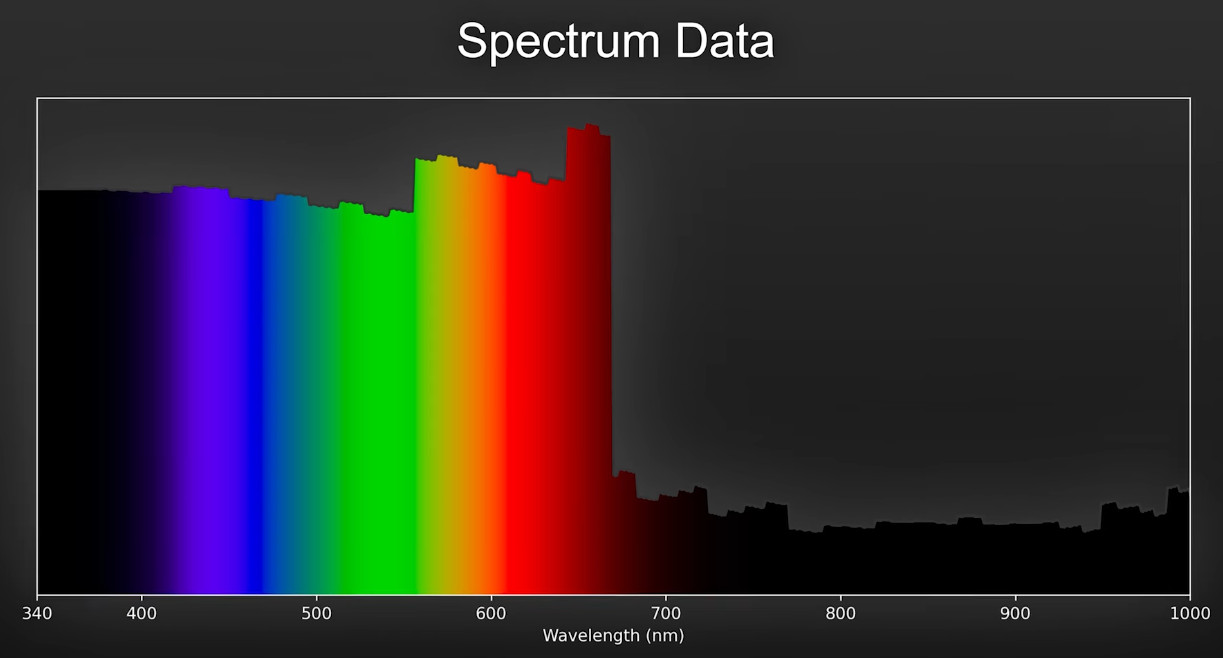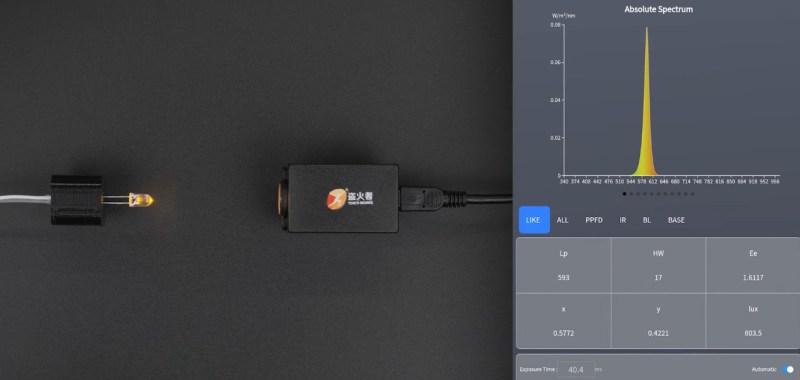A spectrometer is one of those tools that many of us would love to have, but just can’t justify the price of. Sure there are some DIY options out there, but few of them have the convenience or capability of what’s on the commercial market. [Chris] from Zoid Technology recently found a portable spectrometer complete with Android application for just $150 USD on AliExpress which looked very promising…at least at first.
The problem is that the manufacturer, Torch Bearer, offers more expensive models of this spectrometer. In an effort to push users into those higher-priced models, arbitrary features such as data export are blocked in the software. [Chris] first thought he could get around this by reverse engineering the serial data coming from the device (interestingly, the spectrometer ships with a USB-to-serial adapter), but while he got some promising early results, he found that the actual spectrometer data was obfuscated — a graph of the results looked like stacks of LEGOs.

His next step was to decompile the Android application and manually edit out the model number checks. This let him enable the blocked features, although to be fair, he did find that some of them actually did require additional hardware capabilities that this cheaper model apparently doesn’t posses. He was able to fix up a few other wonky issues in the application that are described in the video below, and has released a patch that you can use to bring your own copy of the software up to snuff.
But that’s not all — while fiddling around inside the Android tool’s source code, he found the missing pieces he needed to understand how the serial data was being obfuscated. The explanation to how it works is pretty long-winded, so we’ll save time and just say that the end result was the creation of a Python library that lets you pull data from the spectrometer without relying on any of the manufacturer’s software. This is the kind of thing a lot of people have been waiting for, so we’re eager to see what kind of response the GPLv3 licensed tool gets from the community.
If you’d still rather piece together your own spectrometer, we’ve seen some pretty solid examples you can use to get started.
















This is interesting, I could find it useful for measuring the spectral output of LED’s. Especially white ones when building light panels.
I wonder if the Android app patch fixes any opsec issues too?
I’m not keen on locked down hardware but patch files, this feels different, feels like piracy, so, what’s next, crack files and keygens for Autocad or are we a way off that yet??
Hopefully we’ll get there soon if we aren’t there yet.
If you buy it, it’s yours to do whatever you want with it. Don’t give the device the functionality if you don’t want people to use it.
Same with heated seats in BMWs. I buy a car with a heating coil in the seat and a relay to switch it? I’m gonna use it.
” crack files and keygens for Autocad ”
Yep….Soon I hope.
Just as unlocking seat warmers for free instead of $5/mo is not “piracy”, so isn’t this. The hardware is there and belongs to the user, they should be able to use and communicate with it freely.
Not only should the user have this right ethics-wise, users have the right to RE such obfuscation in the EU legally.
There is some irony there, given the example is BMW
I agree with hardware hacking to enable functionality but this isn’t a hardware hack, it’s cracking/patching a piece of application software to enable extra features that weren’t paid for.
So, as far as I understand it, it’s piracy.
However, if you can show me which EU law allows cracking licensed software then I’m happy to change my opinion.
Cling on to whatever entitled option you want, we don’t want it.
Most likely is a general chip across all lines will be used (economics of one), then specific functionality will be behind blowable fuses, demonstrating possession or lack of is determined by control, not presence.
https://chicagounbound.uchicago.edu/cgi/viewcontent.cgi?article=2487&context=law_and_economics
I think I agree with you on this one, Anonymous. If he looked at the serial data and figured out what it meant, and then wrote his own software to interpret it I would think he was clever. But if he is reverse engineering a piece of non-open source software to enable features he didn’t pay for that are available if he made a different purchase and then teaching others how to do the same, I think it is morally wrong.
Of course I have no idea how the laws would actually interpret this.
CNC Machines famously have unlock codes for almost every option. High speed machining, 5000 dollar option. Bolt hole circle conversational, 800 dollar option. Its all in the based code, and the hardware (if any is even required) exists in the machine already. I can order those options even today for a 20yr old Haas machine and with a phone call they’ll give me an unlock code. Would I love those options for free? Yes of course, but they cost money to develop and the piecemeal system lets people get into machines for cheaper. Of course I don’t have to pay a monthly fee to turn the machine on either.
I think they assemble the seat heating functionality with a loss, if never bring activated.
Once people buy the feature, more than these costs return. So they go into a risk investment. Enabling them is not theft.
But offering the service for money may be the case (just like selling hacked windows licenses)
My man, are you April Foolin’ us?
1) The company selling the product lied about the functionality being shipped in that version – software modified to make it not a lie
2) The software was broken (showing sun is green, etc) – software rewritten to work
Now, either you skimmed the article and skipped the video, or you’ve got some weird ideas about who was screwing over whom in this case.
I’d love to see a tear down of the hardware involved. Those webcam spectrometers are fine for roughly profiling bright light sources but tend to be a let down for most anything else. But we are in an era where soon there will be affordable mostly capable hardware hitting the market. So someone please tear one of these down for science and to personally save me money. Well… I already have several diy spectrometers… Maybe I don’t need anymore…
Project 326 did a teardown of their Torch Bearer spectrometer in a review they did earlier in the year.
https://www.youtube.com/watch?v=URxE2nMVzpw
Amazing, thank you. Now a mystery of the Quantum Dots used on the CMOS sensor.
I would love to see some data on the high CRI white LED. Or even if a targeted Blue filter could make it more like an incandescent. Very neat stuff.
Wow nice reverse engineering! Not sure if a hobbiest would ever need one.
Your hobbies clearly aren’t as diverse as other people’s.
He paid for the tool, disassembled the Android binary, and put together so it worked better for him. That’s not piracy. If you go download his work to enhance your device that’s piracy.
This might make hobbyist grading of light quality possible.
Also could probably develop a filter that removes some blue from cheap LED if one was feeling extra hacky.
At least in the US, this is probably “actionable” — not “illegal” per se, but based on prior cases, if someone brought this to court, they’d probably be able to move forward with a lawsuit or other enforcement action — this goes back all the way to 56k modems that were “locked at 28.8” and sold as cheaper modems. People figured out how to unlock and the manufacturer took action.
It’s not like the company would go after individual owners but takedown notices of any info on unlocking features seems a likely action.
This BS situation is all about “ownership” vs licensing and unfortunately in the US you still can’t yet repair your own tractor …
I have found that something like this:
https://www.amazon.com/gp/product/B00MNEAMF4
Stuffed into something like this:
https://www.amazon.com/gp/product/B06WD843ZM
And using Theremino Spectrometer from here:
https://www.theremino.com/en/downloads/automation
Works pretty good.
7 nm spectral resolution. That’s pretty piss-poor. The DIY spectrometer from Les’ Lab is way better than that.
Not sure if anyone’s interested (given all the hate in comments), but I’ve improved on ZoidTechnology’s UI a bit to make it more usable:
https://github.com/wejn/tobes-ui